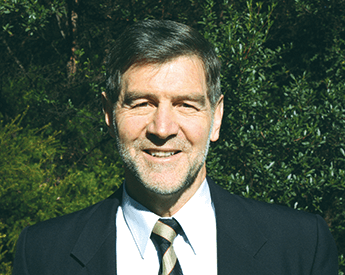
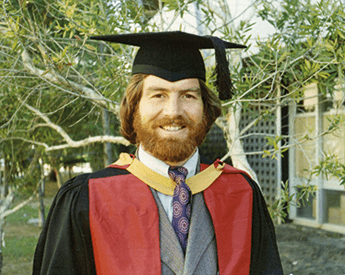
At the age of 15, I was the youngest person ever to be accepted into the Royal Military College, Duntroon – a prestigious training institution for army officers in the Australian Capital Territory. And that’s how my career began in 1966 – in the army – at the tender age of 17, studying mathematics, physics and chemistry equally… It wasn’t possible to graduate with a formal degree from the college back then. Duntroon was in the process of being affiliated with an Australian university, but, unfortunately, that was too late for me. I graduated as a first lieutenant, but somehow convinced the army to send me to the University of New South Wales (UNSW) in Sydney to complete my degree. And so, I found myself doing another two years of chemistry (1969–1971) towards the end of the Vietnam War. The Australian people were very opposed to the war and I was an army officer. It was a pretty hostile environment for people of my persuasion, but I succeeded in disguising myself by growing my hair and a beard (much like the editor of this publication).
During those two years, I discovered a real affinity for chemistry and decided that I’d prefer an academic career. I asked the army to allow me complete a PhD. They initially declined; however, troops were being withdrawn from Vietnam as the army transitioned into peacetime mode, so my application must have looked increasingly inviting. I completed my PhD in chemistry in 1975. I spent the next 10 years or so trying to formally resign from the army, who were making my life very difficult. Eventually, we settled on terms of separation (no pun intended; I had to pay them back some money over a period of time). In addition to fighting with the army, I also found time to spend four years at the Australian National University in Canberra, after which I was appointed back in the department where I had completed my PhD at UNSW and commenced my academic career in earnest. I stayed there until 1992, progressing through the ranks to become a full professor.
I have to admit the only reason I started out in separation science in the first place is because, on my return to UNSW, my head of department told me that I must develop an interest in chromatography – something that I knew virtually nothing about. In fact, my PhD was in an unrelated field – molecular fluorescence spectroscopy – and it’s interesting to note that after my PhD, I never had anything to do with that field again. I guess that proves that a PhD is just a training program; at the end of it, you should be able to do anything you want as long as you’ve learned the correct way to undertake research – that’s something I always stress to my students. In any case, I started learning about chromatography and in the 13 years that followed, sure enough, I developed a keen interest in separation science. And because I had been trained as an inorganic chemist I became an inorganic chromatographer – hence my interest in ion chromatography (see “Three Gurus of Ion Chromatography”).
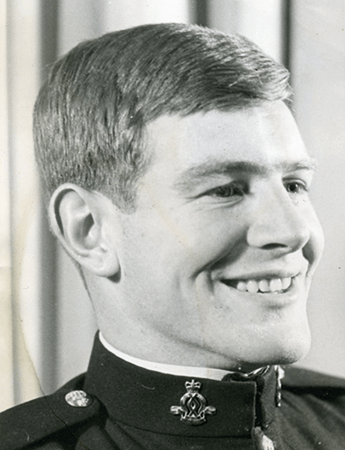
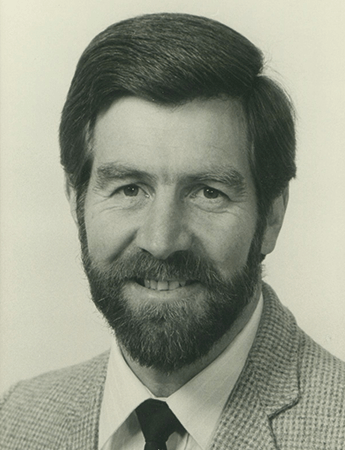
I visited Tasmania for a conference with my wife and family in 1991. It was the middle of winter and we spent one week at the conference and another looking around Tasmania. At the end of the two weeks, I was hooked – there was something magical about it. I walked up to the University of Tasmania in Hobart and asked if they had any vacancies. They did – for a professor of chemistry – but applications had closed. Fortunately, they allowed a late submission. In the interview, my narrow focus in chemistry was exposed – they asked questions about organic and physical chemistry that I couldn’t answer. My entire career, I’d been a chemist in the analytical department of a big school of chemistry so clearly, I spent much of my time enjoying the company of other analytical chemists. It wasn’t looking good. When I was asked at the end of the interview if I had any questions, I said, “Yes, you’ve asked me about every area of chemistry except analytical, and that’s the area I know about – so can I tell you what’s going on in analytical chemistry and why separation science is at the forefront of those developments?” Fifteen minutes later the committee told me I had got the job. My colleagues back in Sydney thought I was absolutely crazy to leave the largest, most successful chemistry department in the country. But I felt it was exactly what I wanted to do. We moved in 1992 to a bit of a rude awakening. When I started at the University of Tasmania, I found myself the head of a chemistry department that naturally covered all aspects of chemistry (a steep learning curve) – but there were no other analytical chemists. Today, the department of chemistry is about 60 percent analytical – a profound shift! I felt that part of my appointment was to develop analytical chemistry – I think history shows that’s what happened.

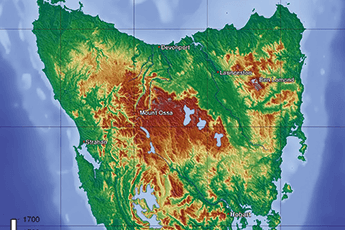
I’d only been head of chemistry for about 10 months when the vice chancellor asked me if I would consider being dean of the Faculty of Science. I was struggling with even being the head of department, which I’d never done before – I was learning about budgetary and curricular aspects and so on. I was shocked to be asked to lead a faculty that contained another 10 schools, covering natural sciences, physics, engineering, psychology, zoology… it was extremely diverse – and accounted for about a third of the university. I doubted my own ability and asked the vice chancellor why I had been chosen. He said, “Frankly, you’re the only one who hasn’t been here long enough to accumulate some baggage – you’ve not upset anyone yet. We think you’d be a safe appointment.” I do like a challenge so I agreed under two conditions. The first was that I stayed in my office in chemistry, and the second was that the faculty paid for a post-doc position for every year that I was dean. The long and the short of it was that my research career was not impeded by being dean, evidenced by no slowing in publications over those nine years. I was blessed with good people around me. I had excellent post-docs, like Brett Paull. And I had extremely good students – Emily Hilder and Michael Breadmore (both in the Top 40 Under 40 Power List), for example.
In 2001, I was offered a third term as dean. But I had decided that I needed to break away from the path towards the higher echelons of university management. I wanted to get back into research. So instead, I applied for – and won – a professorial fellowship from the Australian Research Council (ARC) that allowed me to do full-time research.
It was while being able to focus on research that I got the idea of forming the Australian Centre for Research On Separation Science – ACROSS. The goal was to bring together the major players in separation science around Australia, so that they could collaborate and support each other. Basically, I wanted to lift Australia’s international standing in the field.
I approached Phil Marriot, who was at the Royal Melbourne Institute of Technology (RMIT) University, and Milton Hearn from Monash University. We each got some money together to set ACROSS in motion. There were two agendas – the first was to set up a good network between the universities, and the second was to build up to a critical mass in our individual founding nodes. In 2001, my ACROSS group had about six people – we now have 60 in Tasmania. I should note here that we later took on another node at the University of Western Sydney with Andrew Shalliker. Today, the nodes in ACROSS have a total of about 90 people, so while it is a national center, the critical mass is in Hobart.
I had been enjoying my full-time research position for three years before the Australian government came up with the federation fellowship scheme. In part it was created to prove that it was possible to be as successful taking the research path as it was moving through senior management at a university. The salary was very attractive and the fellowships were offered to all fields, so it was very competitive; there were only 12 positions available annually, as I recall. It took a fourth (and, I had decided, final) attempt before being accepted in 2006 for the five-year position. My plans for ACROSS were clearly a huge factor in winning the fellowship. Once again, I found myself in the absolute luxury of working in a full-time research role, so, all in all, I had eight years completely focused on research, which cleared the way for me to concentrate on the development of ACROSS.
While at UNSW, I had a couple of six-month sabbaticals. The first was in The Netherlands at the Delft University of Technology, where I first met Peter Schoenmakers – I made friends there that I still have today. The second was with Waters at its headquarters in Milford, MA, USA. It was 1987, and I had been collaborating with them for a while. Waters were trying to break into the ion chromatography (IC) space – Dionex had the lion’s share of the market. Waters actually offered me a job, but I agreed to a six-month sabbatical to test the corporate water… I obviously decided to stay an academic, but I worked closely with them for about 15 years. It was a very productive relationship. We got on very well on a personal and scientific level and sold a lot of instruments, collectively penetrating the ion chromatography market – but not enough for the managers, who pulled out in the early 1990s. I was with them at the start – and the end. Both sabbaticals had profound influences on my subsequent work. At Delft my interest was piqued by computer optimization of separations. Here we are, 30 years on, and I’m still working on that. And at Waters, we got a lot of support in terms of both instruments and ideas, which got us involved in some interesting areas. During those days I co-wrote a book on ion chromatography with one of my PhD graduates – Peter Jackson (1). The 900-page tome was published in 1990 and was pretty much the bible of the field for 10 years (cited about 700 times, I think), putting me on the map internationally as far as IC was concerned. And it almost killed me, though it is without a doubt the best thing I did in my career and I feel very proud.
I had thought long and hard about the way I wanted to move forward with my career after stepping down from the deanship of the science faculty. I wanted ACROSS to be my legacy. It was a deliberate strategy and I felt confident that, if I could sell the idea to my university and ARC, I could deliver.
What characterizes the team at ACROSS is solid strength over a breadth of areas. At the beginning, we wanted to assign leaders to different programs within ACROSS so that we could build up expertise equally across the board. For example, Emily Hilder looked after materials science, I ran the retention modeling and optimization program, and Michael Breadmore looked after capillary electrophoresis (CE). We have about nine solid areas where we are very respected by the community. If you ask for the top people in polymer monoliths, for example, Emily will certainly be up there, and the same goes for Michael and Joselito Quirino when it comes to online sample enrichment in CE. We’ve got people at the top of their game. It’s difficult for me to pinpoint individual groundbreaking papers. Rather, I like to look at the collective body of work generated, which I think is outstanding. To prove the point, there is a system in Australia called Excellence in Research Australia (ERA) that ranks research outputs in certain disciplines – analytical chemistry is a recognized sub-discipline. All papers that are published in analytical journals over a six-year period are collected, their citations measured, and then they are compared to global benchmarks. This analysis, in addition to other factors, such as funding received, prestige of staff and fellowships, and so on, is used to produce a ranking of between 1 and 5, where 3 represents the global average. We’ve been assessed three times now and gained the top score of 5 on every occasion.

One of the key objectives at ACROSS was to get people working across the spectrum of separation science so that one individual or group didn’t eclipse the rest, creating friction and unhealthy competition. We mapped out the territory and recruited people to fill the gaps without having too much overlap; for example, we’ve also got Mirek Macka in microfluidics, Rob Shellie in two-dimensional gas chromatography, and so on. We’ve ended up with groups that are more complementary than competitive. And having groups that get along and work well together is the root of our success. We’ve got a very unusual structure at ACROSS. It’s not the typical pyramid of power. When we started, I was the professor at the top with a cohort of people who started at the same level. They were all ambitious and talented; the natural tendency with those characteristics is to try to forge ahead and make your own mark. But working as a collective under the umbrella of ACROSS meant that they could all advance faster than if they were competing for the same resources. In 2001, we had one full professor – we now have six. All of the people that started in that original cohort are now at the top. In academia, it’s typical for people to fight to build an individual empire, but at ACROSS we’ve built a collective empire.
I’d like to highlight one area where our collaborative approach has had an international (and national) impact: counterterrorism. It was about seven years ago, when we were first approached by the Australian government, but in fact, the story starts with a very large explosion in Bali. The perpetrators made it quite clear that they were targeting Australians – over 200 people were killed, of which 83 were Australians – and it was the first time our country had been exposed to terrorism in that way. After the explosion, there was a very large hole in the ground, so it was clearly a big device – likely a ton of explosives, but no one had any idea what material it was made from. No doubt it was an improvised explosive – a fertilizer bomb, for example, which can be made from ammonium nitrate and fuel oil (ANFO). But without confirmation, it wasn’t possible to start searching purchase records to aid in the investigation. It took the authorities quite some time to identify that the bomb was in fact potassium chlorate-based, with sugar and aluminum as the fuel.
We were tasked with developing field tests for post-blast identification of improvised explosives, which could be achieved with ion chromatography or CE. A group of about 10 of us came together to work on the project. We subsequently developed a number of techniques and instruments that have been patented and licensed for production. For example, we made a field-ready CE unit with four channels that can measure inorganic anions, inorganic cations, high explosives (TNT, RDX), and peroxide-based explosives all from the same sample vial. Our efforts attracted a lot of attention. Some of the equipment and procedures we designed is being used routinely by the Australian Federal Police. Next, we were approached by the US Department of Homeland Security, which offered us more funding. Over the years, we’ve probably received about five million Australian dollars to develop not only post-blast but also pre-blast analyzers. Currently, ion mobility spectrometry-based devices are used in airports to screen for explosives. Such devices are very good for organic explosives but extremely insensitive for inorganics. We’ve now built a CE-based device that can identify inorganic explosives by measuring anions. It uses a very short capillary so analysis takes about 40 seconds – a pretty spectacular achievement. And we’ve made a confirmatory ion chromatography test for positive CE results that takes about three minutes. Once again, that technology is on the road to commercialization.
I come from a military family. My father was a lieutenant colonel, and I have two brothers (one a year older, one a year younger) – and we all went into the army. At one stage, we were all officers at the same rank in the same ordnance corps, which looks after logistics and supplies. To make matters worse, my brothers were called Peter and Philip, so we were all Lieutenant P. Haddad – and we all sound the same on the phone. The army probably couldn’t manage that, so maybe that’s why I was allowed to go off to university! At any rate, I ended up with the lowest rank in my family. And in fact, I think I ended up doing what amounted to only six weeks of active service! Nevertheless, the officers’ training course was four years, and I think it’s had an effect on my career. In particular, the army teaches you a lot in terms of leadership; there aren’t many places where you receive such active instruction in that area. We looked at whether it was best to get people to follow you and do as you say, or if it was best to stand back and let good people do the work without getting in their way, sometimes clearing roadblocks ahead without them even realizing – we also learned when each ‘mode’ was necessary. As noted, I spent nine years as the Dean of the Faculty of Science – the largest faculty with the biggest budget and the most students, while trying to maintain a research career. I’m not claiming I’m the world’s best leader, but I think the army did give me an advantage. Any other lessons learnt? Attention to detail is also key in the army – dotting the i’s and crossing the t’s – and I think that’s a useful skill in research. I also learnt how to write properly, as strange as that may sound. I remember when I handed my draft PhD thesis (handwritten I might add) to my supervisor, he gave it back to me an hour later without a single correction and told me it was fine. I’ve had about 70 PhD students and I’ve never given one back without a lot of corrections…

The fact that the US came to Tasmania and essentially recognized us as leaders in the field is hugely satisfying and a great example of what ACROSS can achieve by getting experts to work together.
I long since understood that collaborations with industry and governments are essential for success. When Waters Corporation left the world of IC (see sidebar “Waters Under the Bridge”), it left me free to work with Dionex and later Thermo Fisher Scientific – a fantastic collaboration that has lasted over 20 years. Each year, we’ve agreed on a number of projects, and most of the support we received has come in the form of instruments and consumables, which has been vital in allowing us to grow as a center; we weren’t constrained by the equipment we could afford. Dionex and Thermo have been extremely generous with their support and technical expertise, and we jointly hold a number of patents and products. In 2006, I was approached by Pfizer. They had already set up PARC – the Pfizer Analytical Research Center – in Ghent in Belgium, where Pat Sandra was director. Pfizer was interested in setting up another PARC in the southern hemisphere, and Pat suggested that they talk to me. And so, I received substantial funding to set up PARC Hobart, which funded four PhD students, eight post-docs, and a technician for about six or seven years. The final PARC projects are now coming to a close and it’s been another wonderful collaboration. Over the years, I’ve learnt a great deal about the pharmaceutical industry – for example, where the main problems were and what we needed to focus on to remain relevant.
Bringing everything together, we’ve currently got a government sponsored grant to work with industrial partners – Thermo Fisher, Pfizer and LC Resources – to work out a way to predict the retention of a compound on the basis of its chemical structure. It’s a very ambitious project with a great aim. The software will predict the technique, the type of column and the mobile phase needed for a target compound. A pharmaceutical company like Pfizer spends a lot of time with trial and error searching; scoping out methods in this way could potentially save billions of dollars. The results have been extremely interesting, and I have a strong feeling that we’ll be successful across three fields of chromatography – reversed phase, HILIC and ion exchange. So far, we’ve released just enough information to tantalize people – we’ve had correlations between predictions and actual retention times of 0.99... But that’s not to say we want to keep it a secret. In fact, we are actually looking into crowdsourcing the whole project after we’ve proven the concept. Clearly, the key is in having a big enough training database, so we will need lots of carefully measured retention times – and the best way to do that is to get people to contribute. If we have a consortium of pharmaceutical companies, we can build up the database – in return, they get to use the software. Pfizer is now moving very much into an open innovation environment. Gone are the days when a pharmaceutical company keeps everything to themselves; the only way that big pharma can continue is by working with each other. And this project is an excellent example of that. It’s a very exciting way to finish my career – it combines the things I like doing best: working with highly respected colleagues from two of my long-standing collaborators and my fascination with computer modeling and prediction, which started back when I visited The Netherlands for a sabbatical 30 years ago.
In 2013, I stepped down as director of ACROSS, and I’ve been phasing out my responsibilities and passing them onto the new director – Brett Paull. I will formally retire on December 31, 2014. Looking back over the years, I would have to attribute my success to two abilities: the first is being able to recognize an opportunity when I see one, and the second is being able to recognize (and attract) talent. If you can create a network to combine those two aspects, you get good people working on good opportunities – and the rest follows naturally. My role has been relatively minor. I put the structures in place – but the developments and successes come from the team who has worked at ACROSS. You cannot underestimate the power of Tasmania to attract and keep talent. Certainly, ACROSS offers an excellent scientific environment, but it’s matched with a great physical environment. And so, the caliber of people is extremely high. I don’t know many places where you have a collection of 10 really top class individuals with international reputations that are complementary to each other. That’s a winning formula.
References
- P. Jackson, P. R. Haddad, “Ion chromatography: principles and applications.” (Elsevier, Amsterdam, 1990).




